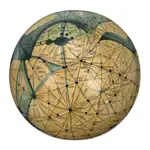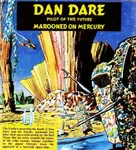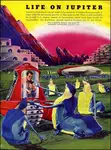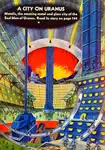the sunport vista:
zendexor's
oss
diary
June 2017
Thought for the day...
2017 June 26th:
WHAT'S TO COME ON THE SITE
It has been a while since I produced any new pages. I hope that will change next month. I want to get back to doing new pages, and extensions to some existing ones, to cater for a queue of topics that grows ever longer.
For this reason and because of a number of other increasing calls on my time and mental energy, I am saying farewell to this Diary habit for the time being. I have kept it up for a year and it has enormously increased the richness of the site - but it has also pressured me quite a lot, and now that pressure is squeezed out by competition from other pressures... If I had nothing else to do, I could go on indefinitely finding topics to chat about, day after day, for years to come, but it's no use pretending that I can do everything I want to do. And my readers may agree, I suspect, that it's time to bring on some new pages.
You'll see at a glance from the statistics on page view winners that the Diary has been very popular, but maybe it has done its job of providing a sort of ocean of references in which the other pages can swim - if I may resort to such a peculiar metaphor.
The ocean will remain, and now it's time for more swimmers.
A grateful Kaor! to all the Diary's regular readers. Who knows, when I become a gentleman of leisure, it may return, or even before then I may resume it as a minor blog, not the ambitious essay-a-day thing it was before, but a sort of noticeboard on which to leave messages... we'll see how it goes.
2017 June 25th:
TREBLE TROUBLE ON TITAN
Strangely, there appear to be no fewer than three works of science fiction that bear the title Trouble on Titan.
One is a novel by Alan E Nourse which appeared in 1954. The other two are shorter tales.
One is the 1941 story by Arthur K Barnes which is discussed on the Titan page.
And the other is a story by Henry Kuttner (Thrilling Wonder Stories, February 1947).
Now, given the tempting alliteration of Trouble on Titan as a title, I suppose it is only mildly surprising that it was given to three different stories. But there is a bigger surprise in connection with the two shorter pieces.
They share their characters! Kuttner's protagonist Tony Quade of Nine Planets Films, and his irascible boss Von Zorn, had already appeared in Barnes' Titan story and in other adventures in the Gerry Carlyle series - and Gerry herself is mentioned, though she does not appear, in Kuttner's story. In other words, the human background is the same in both tales. So their similarity in titles can hardly have been an unconscious error by the later writer. Kuttner must have known, and must simply have not cared. (Unless, of course, the editor of Thrilling Wonder Stories was responsible for the tale's title.)
And now here's a further complication, which furrows the reader's brow even more:
In these tales by Kuttner and Barnes, although the human personnel is the same, the versions of Titan seem different!!! In Kuttner's version there is no mention of the centaurlike Gora which appear in Barnes'. Instead we have an equally well-imagined but very different race of amphibious "Zonals".
Fortunately, since Titan is admitted in both stories to be largely unexplored, there is no flat contradiction between the two separate accounts - we can simply assume that they deal with two unrelatedly different areas on that world.
Perhaps on a harsh and cold world, where conditions discourage travel and the intermingling of species, it is indeed more likely that such separate evolutions of intelligence will occur, huddling, as it were, around their separate fire-places - though this theme is not made explicit in either story.
Anyhow, come to think of it, what about C S Lewis' version of Mars, where there are three separately evolved intelligent species?
Yes.... it's all right. The inner censor issues the stamped certificate: "Disbelief Suspended".
2017 June 24th:
PERMISSIBLE INVENTION OF MOONS
OSS writers can get away with inventing asteroids, easily enough - the real Belt is full of unknowns, and the OSS Belt so much more so, that it allows even a quite large planetoid to be undiscovered until the hero stumbles across it.
A similar, though lesser, freedom is allowed to authors who invent extra moons.
To write about a fifth major moon of Jupiter, on a par with the four Galilean satellites, would be going too far. It would snap the bounds of acceptability unless there was some special reason - a zone of invisibility around the mystery world, maybe. But smaller Jovian moons are permissible without the need to make special excuse. (Indeed, there must in reality be many unknown little ones still undiscovered.)
Today on my shelf of magazines I came across a short story by Murray Leinster in which he invents a small moon of Jupiter.
Incident on Calypso (Startling Stories, Fall 1945) is quite a powerful little piece about a space-farer who thinks he is doomed after crashing with a limited supply of air on the desolate little world. Steve Baring believes he will die alone after a couple of months.
...He had no hope of any sort. Calypso had been surveyed back in 1982 and offered no inducements for further exploration. It is four hundred million miles out from Earth, it is in Jupiter's gravitational field, and it is airless. Which last means that its surface is all pock-marked with ring-mountains made at the same time as those on Luna and Io by that unthinkable mass of stuff that barged through the solar system a hundred-odd million years ago. Nobody else would be turning up on Calypso to rescue him. He was through when his air gave out. Finished. Period.
But then he saw the footprints...
Steve discovers that he is not alone after all - there are other castaways on Calypso: humanoid metal beings whom he thinks at first are robots...
I won't give away the plot. The emotions, the characters, the aliens, the discoveries are well done. Just one point about the name of this Jovian moon:
Murray Leinster didn't have the luck that Edmond Hamilton had, in the moon-naming business. Whereas Hamilton seems prescient in his use of "Styx" and "Cerberus" as moons of Pluto decades before the names were in actual fact assigned, the name "Calypso", by contrast, has now been given to a moon of Saturn! Oh, well.
2017 June 23rd:
A PREHISTORIC WORLD WAR
Again, like yesterday's Diary, the scene is Earth. I am often drawn to writing about that wonderfully exotic orb. Stories set in the distant past or future of this planet combine the advantages of other-worldliness and this-worldliness. Emotionally they thus link Terran time-stretch with the spatial rovings among other worlds of the Old Solar System: both kinds of roving are bracing to the mind.
Today my theme is the past - a world war between cetaceans, nine million years ago.
...The peace lasted only until the Western Preceptorate was able to assemble a strike force and form an alliance with several minor preceptorates in the North Atlantic. In a matter of days there were mass strandings all along the coasts of the then wider continents of South America, Africa and Australia. Counterstrike followed strike but the Western Preceptorate had been prepared, while the southern superpower had been betrayed by confidence in its own strength...
The undersea civilization of the cetezoids naturally has no control of fire, hence has no technology, no industry - but in compensation it develops deadly mind-weapons. Hence the "mass strandings" - hypnotically induced suicides.
...CM-Zero grew from a calf to a juvenile under close supervision of the seniors, because his physical strength and mental aptitudes had been recognized early. Thus he was well educated, but much of his life had been overshadowed by fear of the ultimate weapon, and of famine. He joined a team that was researching psychoempathic methods, with a view to building their own ultimate weapon, and he soon became a specialist in empathy at a distance...
And how do we modern humans get to know this? Because CM-Zero is in reality swimming around in a research institute in modern Australia... he has been cloned from a body found in an ice pocket.
"...We're rebuilding his brain."
"But the freezing process damages the cells of higher animals," said Theo at once, as confidently as if he was arguing with a tutor rather than contradicting his new boss. "You could thaw a brain out after only one day and the cell walls would be shredded to mush by ice from internal fluids."
"Which brings us to your job - and mine. CM-Zero's brain has nine million years of background radiation damage, in addition to the ice damage from being frozen in the first place. Okay, it might be a mess, but consider this: irradiated people can still think, talk and remember for a few weeks while they sicken and die, so their brains must still be viable. If you were to freeze such a person's brain, the structure would be preserved until it was thawed. Now if we sliced and scanned a frozen brain layer by layer, mapping every axon and dendrite of every neuron as we went - "
"You'd get the structure back, even if the cells get pulped!"
The Miocene Arrow by Sean McMullen is a tremendous story that packs traditional sense of wonder together with sophisticated ideas into its 25 pages. (The tale appears in the anthology of Australian science fiction, Alien Shores (1994), edited by Peter McNamara and Margaret Winch.) Two strands, two viewpoints dominate the narrative: that of CM-Zero himself, as the cetacean struggles to come to terms with his resurrection, and that of the research boss Jim Brennan. The latter's guilt-filled love-life seems irrelevant for most of the story, but the relevance becomes brilliantly clear at the end - when we simultaneously are shown how fantastically dangerous it is to resurrect creatures with unsuspected mind-power, who can turn our weaknesses against ourselves.
If you ever read The Miocene Arrow, you won't forget it.
2017 June 22nd:
RICH OSS BACKGROUND FOR AN EARTH TALE
For today's musings I have in mind a story which came out in 1943 and is set in a near-future California. Despite the Terrestrial setting, the colourful inhabited worlds of the Solar System dominate the tale. This is because the protagonist is the boss of a travelling carnival, a troupe which includes creatures from Mercury, Mars, Phobos, Io, Europa, Ganymede, Callisto and Titan.
I reckon I ought to trawl the story for CLUFFs. But besides that, there are lengthier references to the beings from our neighbouring worlds. And early on, the boss gets to explain, to a new recruit and to the reader:
..."Cat-man from Callisto. My prize performer. They're pretty rare."
"I - I've heard of them. They evolved from a cat-ancestor instead of an ape, like we did."
"That's putting it crudely, but it's close enough. I've got a carload of critters like that, geeks from all over the System. They ain't human, and they don't fit with animals either. Moth-men, lizard-men, guys with wings and guys with six arms and antennae. They all followed evolutionary tracks peculiar to their particular hunks of planet, only they stopped before they got where they were going. The Callistan kitties are the aristocrats of the bunch. They've got an I.Q. higher than a lot of humans, and wouldn't spit on the other halflings."
Leigh Brackett, The Halfling (Astonishing Stories, February 1943)
No COMOLD here, I'm glad to say!
One notable aspect of the story: it's one of the few in the genre that mention native beings from Phobos (the "moth-men").
The carnival seems to include quite a few intelligent creatures who don't mind making a living by being on show. But the Callistan element spells trouble...
As usual with such a tale so full of references to exotic life-forms from planetary locales, I enjoy the read but at the same time am left with a wistful longing to know more - but of course there is no more. It's just a thirty-page story, not a detailed series. And though Brackett did write some connected tales, her Solar System output tends to sprawl disjointedly, with boundaries that are hard to draw - that's to say, it's hard to be sure exactly how much of her work shares a common background.
Of course, when a reader keeps worrying at a question like this, it's a compliment to the writer.
2017 June 21st:
SIDELIGHT ON CERES
In this Diary I have already written about The Ship From Infinity by Edmond Hamilton; see the article Enlarging the Remit.
I didn't mention, though, the light it sheds upon the largest asteroid.
Adding value / personality / character / immanent mystery to a dim and sterile lump of rock is a speciality of the sf fan mentality. It's not just any old lump of rock, you see - it's Ceres, the almost planetarily vivid asteroid. Rather neglected in literature; in fact, it's as sparsely catered for as was Uranus before the publication of Uranian Gleams. We need an equivalent "Cerean Gleams". Until that happens, we must rummage and snatch what scraps we can.
The Ship from Infinity gives us some reasonably generous access to the place.
...The tramp docked at last on the flat tableland of bare black rock beside Ceres' clustered domes. Sealed trucks took them from the ship's lock through the airlock of the dome, dumped them, and went on.
Farrel stood for a minute with Tolti beside him, looking around. She was starting up at the plastic dome with black sky on top of it, and the stars, and the Sun that was no bigger than a Christmas-tree ball and not much warmer. Farrel was used to that. He was looking at people, at the blackrock streets and the dirty plastic houses...
All very stark and bleak. So why is it that it thrills me? How does it work, this boost that a scene in a tale gets from being set on this particular asteroid?
It must be an infusion of power from a network of ideas and associations. Hamilton's story is good, but it can't provide the singular fascination of the Cerean scene all by itself. He's drawing on a reservoir of power.
That reservoir is the indefinite integral of all the tales that have ever been written, plus all the thoughts that have ever been thunk, about that little world.
They fall together into a mass that accretes till it switches on, like the infalling matter of a protostar. The switch-on creates the fused magic of an OSS world.
Hamilton's tale provides one of the larger fragments of input.
...They left the storage area and plunged into the narrow blackrock streets, crowded with people and crammed with pre-fab plastic buildings that housed everything in a sort of insane democracy. Churches and bars were cheek-by-jowl, sometimes on different floors of the same building. Bordellos, hospital, civic offices, a thriving mortuary, mining company offices, assay offices, machinery and supply companies, lawyer's offices, countless cubby-holes full of people, all jammed together in the inflexible circles of the main dome and the three smaller ones it had been forced to sprout in the slightly more than a century since the first ships had landed on this, the largest of the minor worlds...
That's the inside; and he gives us some of the outside too.
...The map showed several small outfits of various sorts dotted around in the South Polar area but the big mine had been abandoned for years. With any luck, if the truck kept running, they could stay out of sight of the small camps, dodging around the rock pans, creeping without lights if they had to. Every mining camp had a radio, and the minute they were seen and reported they were through.
The road climbed between jagged walls. The pass opened, narrow and forbidding, and then they were heading down the farther slope with the glimmering expanse of the southern rock-pans spread out before them...
There were no roads on Ceres except where a pass or a fill had been necessary. Taking turns at driving, the two men pushed the truck farther and farther into the barren antarctic regions - a South Pole both worse and better than the Earthly one that had cost so many lives and so much agony. Worse because life of any kind was a precarious intrusion on this sterile rock adrift in the void between Mars and Jupiter, existing from minute to minute only by the complicated interdependence of mechanical aids. Better because the rock was sterile and airless, with neither wind nor snow nor ice to trouble it. Such as it was it was, unchanged and unchanging.
This is the fullness of emptiness; the stark removal of distractions leaving us close to the infinite, which comes crowding in, pressing upon us so that the "void" is packed dense with some numinous reality.
Mind you, I'd rather eat my cake and have it. Combine the power of bleak starkness with the power of organic life...
All we need are some troll-like native Cereans who don't need to breathe and are happy to eat rock.
Or maybe a hidden network of valleys, deep enough for air-pockets to linger...
2017 June 20th:
NOT SURE WHERE TO PUT IT? TRY AN ASTEROID
If you're an OSS author in search of a setting for your latest tale, and you don't want the plot-commitments which might arise from a setting on one of the major planets, then - just choose an asteroid!
The real asteroid belt isn't likely to fit the bill in this way, but the OSS Belt sure can!
Take for example The Fear Planet...
...We were elated when we nosed down. Benson's indications on atmospheric pressure, density and component analysis showed we could step out freely without using our insulated suits. Moist air, and almost too much oxygen. Temperature above eighty...
Wow, the liberties one could take with scientific fact in those pulp-fiction days - and how those liberties benefited the Belt! It became a kind of free-for all, a zone where one might find absolutely anything. The thematic frontier of the Solar System.
Of course the System has other mysteries, other frontiers; you can invent plenty when setting your tales among lost cities of Mars or under the clouds of Venus; but those worlds have fictional traditions which to some extent impose their own agenda, and besides, whatever version of known planets you invent, you can't go so far as to claim that they're newly discovered. The littlest undiscovered worldlet in the Belt therefore has something which Mars and Venus can't have - total global unpredictability. A blank slate for the emotions.
This advantage is seized by those authors whose attitude to science is most happy-go-lucky: e.g. Ray Bradbury, and Robert Bloch who wrote The Fear Planet from which I quote in today's Diary.
Such writers, fortunately for us, can even create asteroids with Earth-normal gravity and temperature, and a rich ecology... worldlets which yet retain the asteroidal romance...
...I squinted out at the surface of this miniature earth. In my time I've done a little serious drinking. I've seen pink elephants. But this was the first time I ever saw green nightmares.
That's what the place was - a green nightmare. Nothing but forest, as far as the eyes could see - a lush, tropical green forest. Swamp-like growths rising out of mud that was not brown, but a verdant green. And twining through mazes of twisted vegetable tentacles was the mist. The livid mist of coiling, greenish steam...
I have not been able to find out when and where this tale by Bloch was published. I have it in my copy of August Derleth's anthology Far Boundaries, which is dated 1951.
Those, as I say, were the days. I know that we're experiencing an OSS resurgence at the moment, but I somehow doubt if even the current crop of Neo-OSS writers will develop the audacity to set scenes on asteroids with Earthlike gravity...
2017 June 19th:
EVERGREEN PROMISES
I feel another bout of far-fetched analogy coming on.
When the passage of time moves controversial politicians far enough into the past, that we can think of them as historical figures rather than as incitements to high blood-pressure, it sometimes becomes apparent to the fair-minded, that some of them had a certain greatness, despite their faults, and this greatness may consist not just in achievements but in embodying a certain hope. I'm thinking of Gambetta in France, and Lloyd George in Britain, for example. Perhaps Stresemann in Germany... the model for the character Loeffler in John Buchan's A Prince of the Captivity.
Now for the other end of the analogy. There are writers, and books, and series of books, which embody a kind of hope, which makes us go on reading them despite their faults, because we so much want to find in them what they promise to contain.
Today I reread a story which disappointed me the first time I read it. I had thought it over-long, long-winded and (to be honest) boring in its emphasis on a certain kind of evil, which the author seemed to rely on too much.
This time I found that I could get three-quarters of the way through before I got bored. Much better than last time. Yes, but why keep trying? Ah, there's the point.
...He stepped into blackness that closed about him like water as the door swung shut. He stood there with quickened heart-beats, hand on his gun, listening. A blue light, dim and ghostly, flooded the place without warning and he saw the doorman had crossed to a switch at the far side of the tiny chamber wherein he stood...
Black Thirst is a closed-in story full of oppressive imagery, mostly set indoors. Granted, it starts outdoors, but even that opening scene is dark and prison-like with the tideless lapping of the black waves against the waterfronts of Ednes, Venus. I wanted - I still want - more room in sf adventure; I read sf for vistas, and not to get mired in murk.
But now I see more in C L Moore's story than I used to. What's happening to me? Answer: the lure of promise. The Northwest Smith stories all have irresistible opening scenes. They remind me in that respect of Ian Fleming's James Bond books, which start much better than they end, and to which every so often I am bound to return, hoping that the areas of disappointment will shrink further next time, as my appreciation of the Bond saga's many good points grows.
The day may come, when the power of promise entirely swallows up all the disappointments, so that the "promise" of such works turns into an actual delivery.
In a sense it has already happened. James Bond and (to a smaller reading public) Northwest Smith have achieved the status of myth, and with myth you are touching a power beyond the reach of disappointment.
2017 June 18th:
THE NEW MARTIANS
Readers will doubtless be familiar with the conclusion of Ray Bradbury's Martian Chronicles, in which the remaining Terrans on Mars are exquisitely re-defined, with typical Bradburyesque flair, as Martians.
Another Ray, Raymond Z Gallun, does the same thing with far more practical detail but also with equal stress on the psychological side, in his tale of adaptation, Return of a Legend (Planet Stories, March 1952).
The Mars of this tale, like that in Miller's 1953 tale discussed yesterday, is a harsh place with an atmosphere un-breathable by humans. Perhaps we can place the early '50s as a time when Breathable Air Mars is slipping below the threshold of fictional plausibility for many writers.
However, whereas the Mars of Crucifixus Etiam is presented as quite unattractive, with no native life other than lichens (but think how the entire Mars-watching public would welcome even lichens with open arms nowadays!), the Mars of Return of a Legend is far richer in heritage, both biological and archaeological.
The story seems fuller than any 16-page story could possibly be. Early on we listen to colonists trying to figure out how a tramp called Dave Kort managed to survive three Martian years out in the Red Planet's wilderness before disappearing for good.
...How Kort had turned the trick was not completely inconceivable.
In making starch from carbon dioxide and moisture under the action of sunlight, the green plant life of Mars produces oxygen just as Earthly vegetation does. But instead of freeing it lavishly to the air, many of those Martian growths, hoarding the essentials of life on a dying world, compress their oxygen into cavities in stem and root and underground capsule, to support later a slow tissue combustion like that of warm-blooded animals, thus protecting their vitals from cold and death.
Despoiling these stores of oxygen with a pointed metal pipette attached to a greedily sucking compressor was a known means of emergency survival on Mars. Thus you could laboriously replenish the oxygen flasks for your air-hood. Simple - yes. But tedious, grinding, endless...
Food and shelter were also necessary. But under thickets there is a five-foot depth of fallen vegetation, dry, felty, slow to decay in this climate, accumulating autumn after autumn for Martian centuries. In this carpet are those oxygen-holding capsules and roots, often broken, freeing their contents for the spongy surrounding material to hold... And there, the remaining animal life has retreated.
Fuzzy, tawny things that twitter; fat, mammal-like excavators that never care to see the sky, and many-jointed creatures that resemble Earthy ants only in their industry and communal skills. Above ground they build their small, transparent air-domes - bubble-like structures formed of hardened secretion from their jaws. There they shelter their special gardens and sun their young.
So, for a man able to borrow methods unlike his human heritage, there were ways to keep alive in the raw Martian wilds.
That, broadly speaking, sets the physical scene. We are left with the question "why try to live out there?" The majority of the colonists in their sheltered domes wonder at the few who run off into the wilderness. When some children try it, adults follow, searching, trying to get them back - and finishing by becoming "Martians" themselves.
Gallun's tale is a great read particularly if you're in the mood for a realistic-but-also-romantic Worn Out Mars.
2017 June 17th:
SACRIFICES FOR A FUTURE MARS
It's fairly well known that Edmond Hamilton wrote a one-off exception to his usual exotic Mars locales: the unusually unpleasant Mars-is-a-dump scene of his story What's It Like Out There?
It is also well known that Philip K Dick seconded this bleak view of the Red Planet in his The Three Stigmata of Palmer Eldritch.
Now there's a third story which, on the purely material plane, portrays a Mars every bit as depressing as the first two I've mentioned. But there is a vital difference.
The difference is not apparent for quite a while, indeed the story has to build up to it before we arrive at the more positive message.
The ordinary workers on Mars are treated far worse than the engineers and the higher-ups. The young Peruvian protagonist wears himself out for a purpose which is hidden from him for most of the story.
...He had been on Mars only a month, and it hurt. Each time he swung the heavy pick into the red-brown sod, his face winced with pain. The plastic aerator valves, surgically stitched in his chest, pulled and twisted and seemed to tear with each lurch of his body. The mechanical oxygenator served as a lung, sucking blood through an artificially grafted network of veins and plastic tubing, frothing it with air from a chemical generator, and returning it to his circulatory system. Breathing was unnecessary, except to provide wind for talking, but Manue breathed in desperate gulps of the 4.0 psi Martian air; for he had seen the wasted, atrophied chests of the men who had served four or five years, and he knew that when they returned to Earth - if ever - they would still need the auxiliary oxygenator equipment.
That's Manue's great worry - that he will forget how to breathe, and will have to depend on the "oxy" for the rest of his life. But at night, he finds he has to switch it on high or he never sleeps...
Crucifixus Etiam by Walter M Miller (1953) is a superb 20-page story, perfectly shaped, perfectly written, leaving a permanent resonance in the mind. I can't imagine any better account ever being penned, of a humble worker's urge to find meaning in his labour, of him finding it, and concluding that the terrible personal price he is paying is worth while.
Mars - the workers finally learn - will be given a breathable atmosphere in eight hundred years. Physically they are broken men, but they have sown something great.
The supervisor sees Manue Nanti struggling with his clogged lungs.
"Some sow, others reap," he said.
"Why?" the Peruvian choked.
The supervisor shrugged. "What's the difference? But if you can't be both, which would you rather be?"
Nanti looked up into the wind. He imagined a city to the south, a city built on tear-soaked ground, filled with people who had no ends beyond their culture, no goal but within their own society. It was a good sensible question: Which would he rather be - sower or reaper?
Pride brought him slowly to his feet...
The Mars of this story is an ugly place, every bit as unpleasant as the Mars of the Dick novel mentioned above. The difference lies in the attitude.
2017 June 16th:
CRATERS YES, DISH HOLES NO
I like the moon cars in the picture, but I'm not so keen on the idea that young children should be talked down to, as they are by the authors of You Will Go To The Moon, Mae and Ira Freeman, who introduce lunar craters as "dish holes".
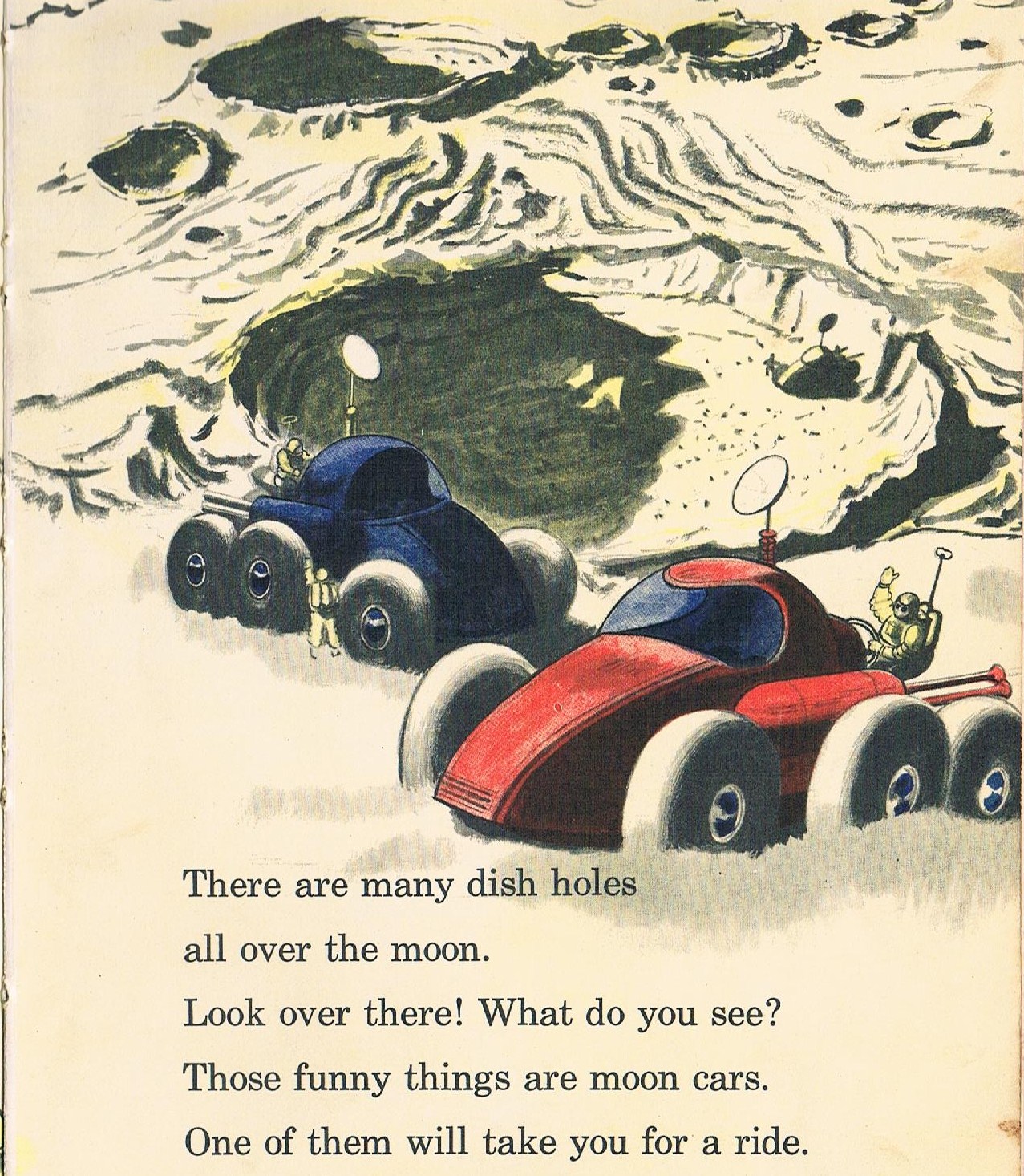
A new word, to a child, ought to be a wonderful thing. In a way, it's like: new word = new world. How silly to call a crater a "dish hole". It's the one lapse in an otherwise fine book for little youngsters. I well remember my little self being puzzled, a bit put out that the craters were so mis-named. But then, how did I know the right word? When did I first learn about craters? Perhaps the reason I already knew the word, was that I had been fortunate enough to read Finn Family Moomintroll, in which Tove Jansson mentions that the Hobgoblin, in his quest for the King's Ruby, had searched the craters of the moon. Or perhaps I learned it from some encyclopaedia or other science text for youngsters.
Whatever the case, there's nothing to be gained from calling craters "dish holes".
I think, moreover, that children don't need to have the origins of words explained at all. I'd guess that most children, perhaps all, are as uninterested in I was at knowing where words come from, and this is part of a young person's acceptance of things in their pristine newness of discovery. I say this to forestall anyone who feels like pointing out that a crater is a dish. Or at any rate a cup, in the original Greek meaning of the word (and their cups looked more like bowls).
Another example is the word "planet". It has a magic all its own. Never mind that it meant "wanderer" - that's mildly interesting, but most important is the sheer allure of the very sound of planet.
2017 June 14th:
UL QUORN BACK FROM THE DEAD
Captain Future's arch enemy Ul Quorn, who supposedly perished in the Edmond Hamilton novel named after the super-villain's sobriquet The Magician of Mars, returns unexpectedly in Manly Wade Wellman's The Solar Invasion.
Mostly, I was unimpressed after my first reading of Wellman's attempt at a Captain Future novel. But now I'm having second thoughts. Looking at it again, I find, for one thing, that it contains a fascinating idea of an ultra-dimensional version of Earth's Moon - a Moon that is a kind of counterpart or other aspect of ours, but full of organic life. That reminds me of the other aspect of Earth provided by the Kroth trilogy.
I'm also not quite sure why I didn't appreciate, the first time, the portrayal of Quorn and his mistress, N'Rala. They seem as vivid as they are in Hamilton's work.
Something, maybe, is still lacking in the book, compared with Hamilton's crisper and more exuberant style - but again, is that merely my associational thinking leading me astray? Suppose I hadn't known it was written by someone other than Hamilton, would it have seemed any different?
Anyhow, all this goes to show that instead of a negative attitude to other authors "butting in", one can view the occasion as an interesting experiment.
Perhaps some characters can move into the public domain, more easily than others. The Conan pastiches written by Lin Carter and L Sprague de Camp don't seem to me to be a patch on the Howard originals; but Captain Future, though chronicled mostly by Hamilton, is, perhaps, more of a "mover".
Has anyone any comments on the new one - Avengers of the Moon by Allen M Steele?
2017 June 13th:
THE LIT-DIMENSION
First, let me quote from Arthur C Clarke's Profiles of the Future:
...The writer cannot escape from his environment, however hard he tries... When the frontier is open we have Homer and Shakespeare - or, to choose less Olympian examples nearer to our own age, Melville, Whitman and Mark Twain. When it is closed, the time has come for Tennessee Willliams and Samuel Beckett - and for Proust, whose horizon was a cork-lined room.
It is too naive to suppose that astronautics will restore epic and the saga in any thing like their original forms; spaceflight will be too well documented, and Homer started off with the great advantage of being untrammelled by too many facts. But surely the discoveries and adventures, the triumphs and inevitable tragedies that must accompany Man's drive towards the stars will one day inspire a new heroic literature, and bring forth latter-day equivalents of The Golden Fleece, Gulliver's Travels, Moby Dick, Robinson Crusoe or The Ancient Mariner...
The point I want to make about this, is not that Clarke's contrast between open and closed literatures is wrong - only that there's a third force which he hasn't considered.
"The writer," he says, "cannot escape from his environment". But the environment is more than he allows for. Literature itself can be considered part of the environment. The mental environment.
This is what has happened with the Old Solar System. It has developed a literary life of its own. It has branched off from the rest of reality - to form a cultural construct, a web of associations, a set of archetypes, a series of triggers for further imaginings.
So even if Clarke's comment is valid for the rest of literature, the OSS sub-genre can henceforth flourish quite independently of the categories he outlines. Whether human civilization is expanding into an infinite frontier or stagnating in the doldrums of regressive introspection, OSS (or Neo-OSS) tales can continue to be written.
Such stories used to be inspired by beliefs about what the Solar System might really be like. Those beliefs provided the fuel for the take-off.
But now, our literary capsule has achieved escape velocity.
2017 June 12th:
THE AUTHOR'S VOICE-OVER
Nowadays, Gentle Reader, it is not considered usual practice for the author to address his audience directly. And yet the practice has continued far beyond its nineteenth-century heyday.
Heinlein remarks on the psychology of his protagonist in Between Planets; Clarke in Earthlight remarks on the fatal tendency in human nature to glory in battle; C S Lewis in That Hideous Strength gives various asides which arise from reflections concerning his terrific cast of characters.
I don't know whether this thought of thing ought to work, but it certainly does work, in the cases mentioned above. Even if it's in some sense against the rules, a great writer can break the rules. Interestingly, though, some great writers don't avail themselves of the privilege. Some, not necessarily the less opinionated, forbear from adding their voice-overs to their tales. The reflections, the musings that appear in those tales are those of the characters, not the author, though doubtless the author often agrees. I'm thinking now of Clifford Simak. His stories are full of thought, but we are listening to his characters think, rather than hearing Simak's own voice directly.
Perhaps the best reason for the voice-over is if the setting and the character are such that there is no other way to convey the necessary idea.
...He huddled back and waited. The rain brawled on. Well, the longer and heavier the fall, the better for him. He had thought he might need several storms, but perhaps this one would do. He slept.
The rain continued through the night and day and night, on into the following morning. A human would not have been able to comprehend the Noachian magnitude of precipitation; but it was not unusual for Jupiter, which is constructed on another scale than Earth...
Thus does Poul Anderson interpose a view of the context of his Jovian rainstorm in Three Worlds to Conquer. He does this because it is not reasonable to expect his Jovian character to make this kind of comparison for terrestrial readers. When you're writing about such a vastly different environment which contains no inherent link to ours, you have to impose that link via a voice-over, if there's something you want said from a Terran viewpoint.
And anyway, why not? Storytellers have licence to comment, in my view.
Nevertheless there is another way of doing it, but I've only come across it in one writer. This substitute for the authorial voice-over consists of giving the characters themselves some kind of special "context-awareness" whch can do a similar job. Robert Gibson's Uranians appear to possess such a faculty. They seem less inclined than most beings to take their environment for granted. I'm hoping that, in a sequel to Uranian Gleams, we will hear more of this idea.
2017 June 11th:
FLEXIBLE SPACE
The freighter Pallas, en route from Jupiter to Neptune, develops a leak in the starboard tank. This leads to a conversation which I find interesting for the light it sheds upon the flexibility of fictional outer space in the Old Solar System. Art affects space, as you may have noticed from watching the old 1933 version of King Kong, in which the gorilla varies markedly in size from scene to scene. Or you may have noticed it in pre-Renaissance paintings which ignore the laws of perspective and lose nothing thereby. Anyhow, here's what's said on the Pallas:
...Rance Kent, first officer... asked a question: "Couldn't we raise Neptune with the radio, sir, and have them send out a fuel ship in time to reach us?"
"It's impossible, Mr Kent," Crain answered. "Our main radio is dead without fuel to run its dynamotors, and our auxiliary set hasn't the power to reach Neptune."
"Why not abandon ship in the space-suits," asked Liggett, the second officer, "and trust to the chance of some ship picking us up?"
The captain shook his head. "It would be quite useless..."
Useless - but note that he doesn't say that the question was stupid!
This extract comes from an early Hamilton effort, The Sargasso of Space (Astounding Stories, September 1931). Not one of his greats, but worth perusal. Especially for the idea that you can just jump out into space somewhere between Jupiter and Neptune and hope for the best as if you were hitch-hiking!
Ah, those were the days.
As you've probably gathered by now, my attitude to these old tales is compounded of amusement at their inaccuracies, with affection and respect for their freshness and exuberance which, I'm convinced, conceal both a vital secret of story-telling and a clue to the workings of the human imagination.
Big stuff hidden away in cheap pulp magazines.
So, rather than sneer, we need to expand our capacity for suspending disbelief when exploring 1930s pulpdom where accuracy is so scarce, just as we dilate the pupils of our eyes when light is in short supply.
2017 June 10th:
IS DICK FOR OR AGAINST THE FINAL FRONTIER?
From what I have read, Philip K Dick was personally in favour of the Apollo missions. He reacted positively to the moon landings. (In this he is perhaps unlike most other "New Wave" sf authors; for example, Harlan Ellison whose response was, "If I were a Martian I'd start running now.")
On the other hand in The Three Stigmata of Palmer Eldritch Dick is very negative about the colonization of Mars:
...Mars, a dreary colonists' hovel... gloomy quasi-life of expatriation in an unnatural environment... (p.43)
But then, back on to the other hand, he's definitely pro-Moon colony in Time Out of Joint, taking the side of Luna versus Earth in an inter-world conflict.
What are we to make of this contradiction?
I suppose that his anti-Mars mood in Three Stigmata is there for the purposes of the plot. It suits Dick in that book to pick on Mars as a sort of image of what modern pressures can push ordinary people into having to accept. It doesn't mean he took a real dislike to the place. After all, in Martian Time-Slip we get a picture of the planet as an environment in which, more or less, ordinary folk can get along. Not the hopeless hole in which the colonists in Three Stigmata have to resort to virtual reality in order to make life bearable.
His best portrayal of another world of the Old Solar System is the Venus of The World Jones Made. Although the Venus we get in the book is, from our point of view, far worse even than the dreary Mars of Three Stigmata, it doesn't matter to the colonists, who have been engineered to like it. Indeed, for them it is the Earth that is uninhabitable. The sense of liberation that comes to them in their new world is wonderful to read.
So, to answer the title question of this diary entry:
Dick had a large enough mind to be in favour of space expansion while simultaneously being aware of how it could go wrong or be misused. And although primarily philosophical writer, interested in exploring the eternal war of deception between reality and illusion, rather than a chronicler of adventure, he nevertheless retained a fondness for the trappings of OSS saga and kept a supply of them to use in his own tales as colourful props.
I'd say his heart was in the right place.
2017 June 9th:
A BOOK WITH THE RIGHT IDEA
My copy of You Will Go To The Moon (1959), by Mae and Ira Freeman, has a muddy shoe-print on pages 2-3, and the spine is a wreck, but it would still be a pretty good way of teaching a young child to read. It starts promisingly:
The moon is up there,
far away.
No one has been there yet.
But some one will go there soon.
Some day you may go there, too.
This is how you will go
to the moon.
Here is the rocket
that will take you up into space.
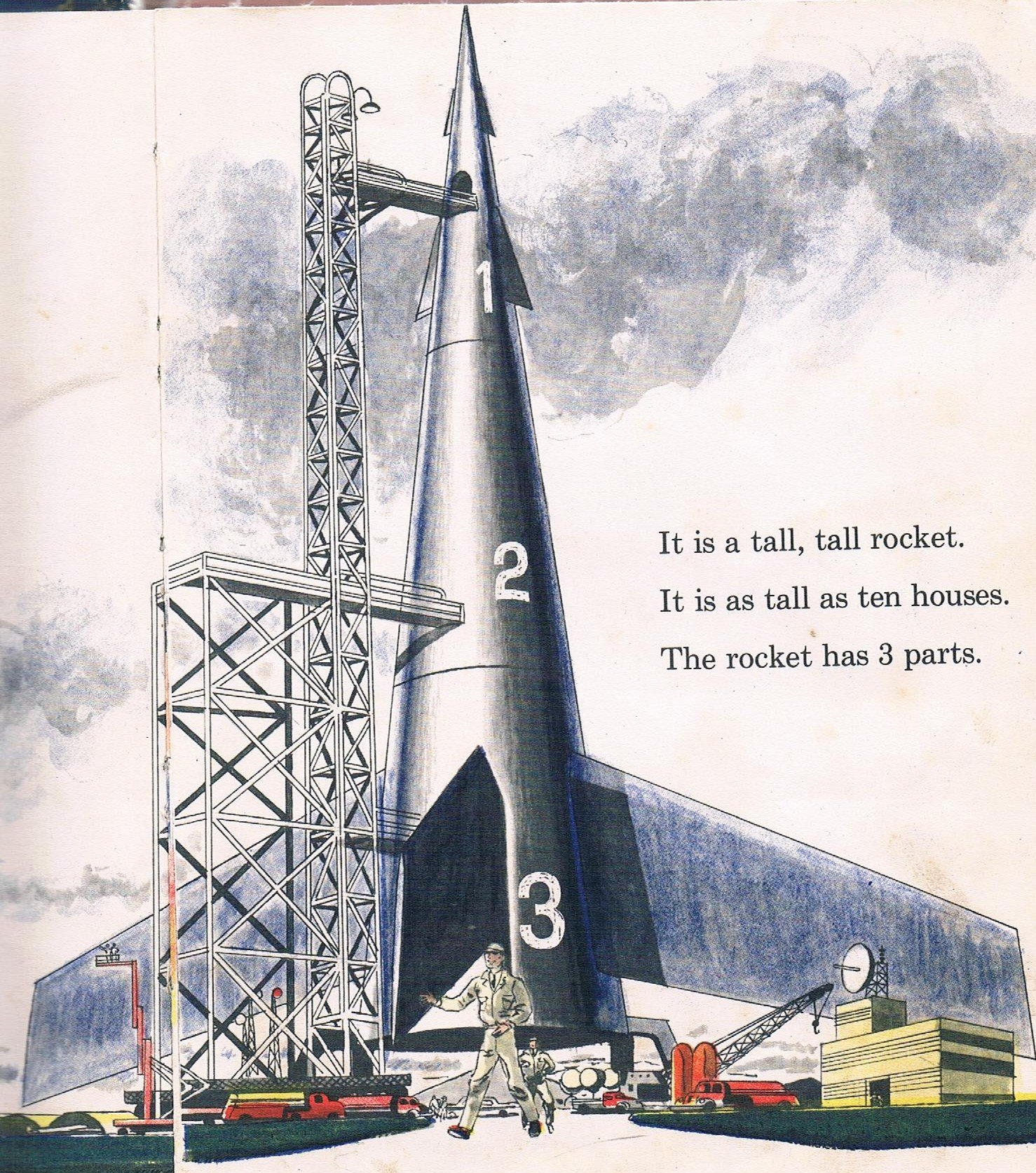
Simple stuff, but note the grand though unnecessary fins of the rocket. This old space program had style. And most of the story seems plausible enough. Note the rocket's 3-step design. I think in fact that the US government could have done worse than use You Will Go To The Moon as a manual for its moon project.
The book is sound on space-stations: there's a proper ringed one.
...Soon you get near
the space station.
Now you can see
that it looks like a big,
big ring.
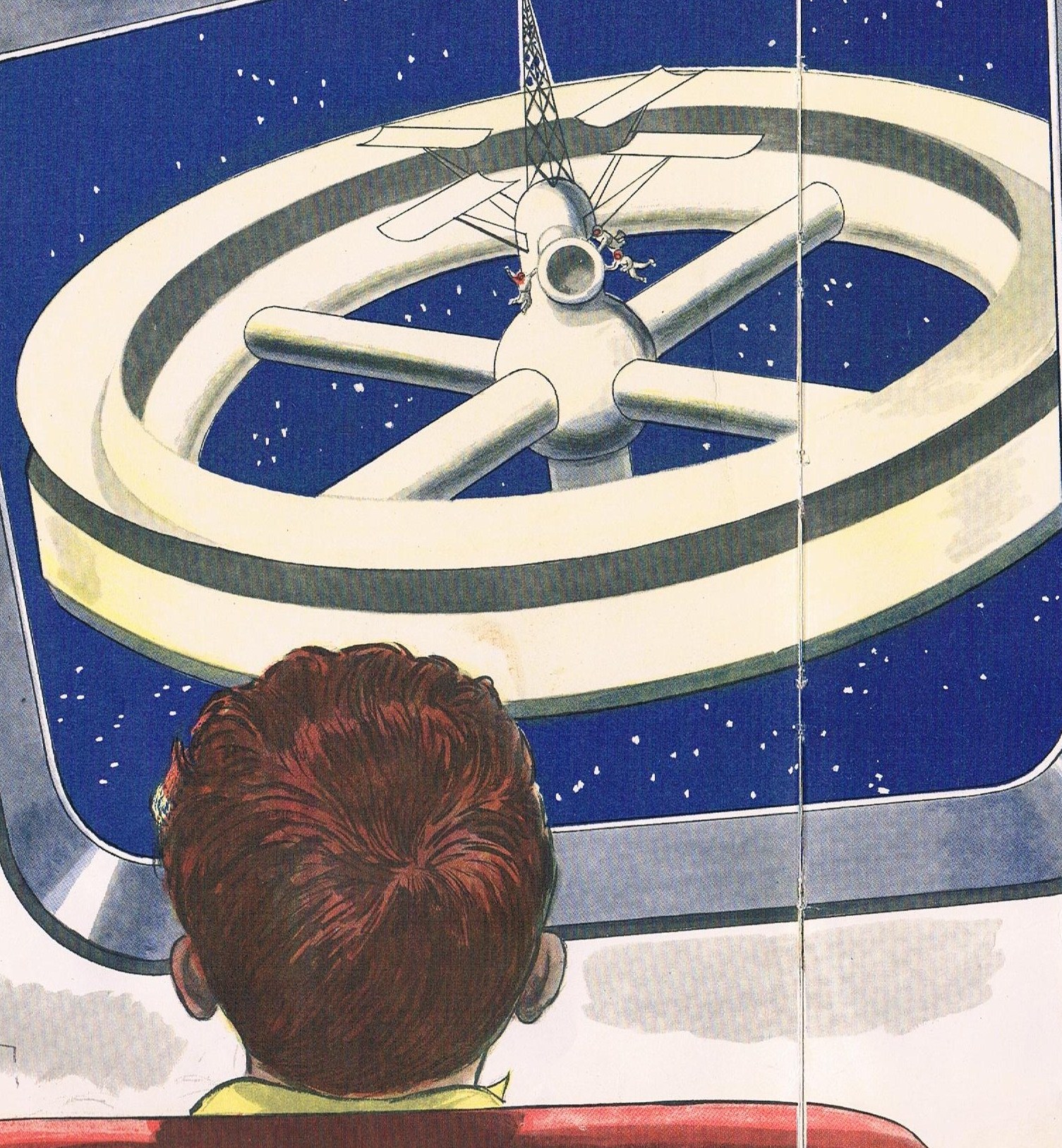
The book teaches the young would-be space-traveller about weightlessness (Open your belt. OH! Up you go. You cannot stay down! You do not fall! YOU ARE A SPACE MAN NOW. At home all things stay down. The pull of the earth holds them down. But not one thing will stay down out in space.) But also you learn that things are different once you get into the spinning space station. (Things DO stay down here. You will stay down too! Why? The space station turns and turns. The turning is what keeps things down. So it is more like home here.)
After a while relaxing in the space station, you point and say to a rocket man:
Look! What is that funny thing out there?
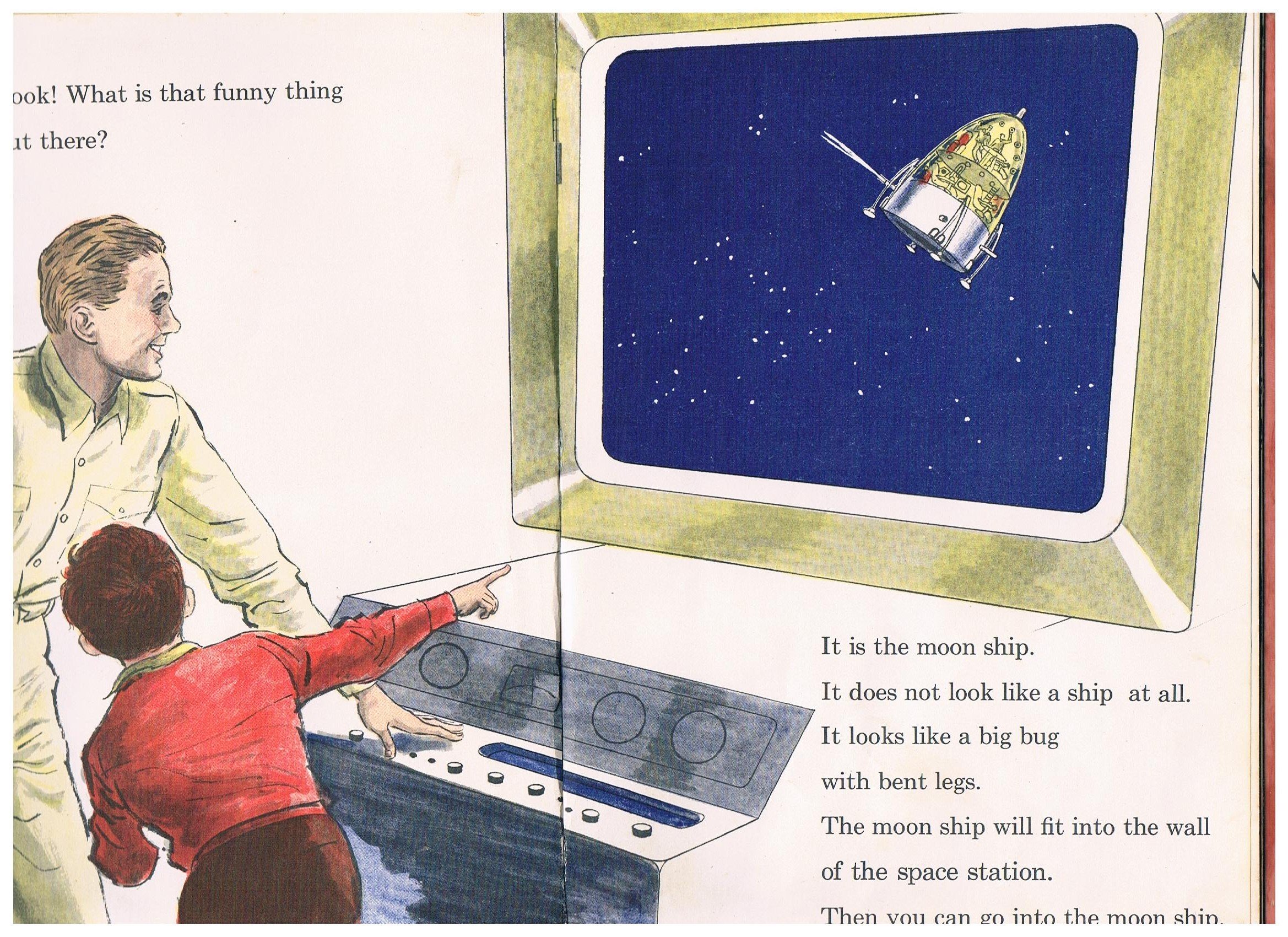
Then you can go into the moon ship...
This is the life for a youngster - not fiddling with computer games... It's high time proper facilities were provided. The book shows what needs to be done. (More on this anon.)
2017 June 7th:
INTERNET FAILURE
I'm writing this in a pub using its WiFi. My home connections are caput and I am having to wait till Friday morning for a call from the engineer.
Even here in the pub my email isn't working properly so my thanks to Dylan for his latest travelogue can't get sent. Hope you read this, Dylan. The travelogue itself will get done after I'm properly back on line. The pub isn't the place for subtleties including input of pictures to files.
Sorry folks.
2017 June 5th:
JOHN CARTER AND ZODANGA - HOW TO GLIDE OVER DILEMMAS
Among the moral inconsistencies - or at least incoherencies - of Barsoom, the sack of Zodanga stands out, along with its preludes and aftermath, as a striking example of how an author can solve a problem by ignoring it.
John Carter leads a savage horde of green warriors to destroy Zodanga in the climax of A Princess of Mars. Yet earlier in the story he had been befriended by some Zodangans, the brothers Ptor.
...They filled a little sack at my side with Zodangan money... When I mentioned my inability to repay them for their kindness to me they assured me that I would have ample opportunity if I lived long upon Barsoom, and bidding me farewell they watched me until I was out of sight upon the broad white turnpike.
Well, the Zodangans' kindness is shortly to be repaid by the destruction of their city. And the justification for this apparent ingratitude? Burroughs just passes the buck to the reader. It's our job to square it. And we do. That's the genius of ERB: he has given us the tools for our imaginations to do the job, and the motivation to hold the edifice together by putting enough of our own efforts into coping with its inconsistencies and conundrums. More than most writing, the Barsoom saga is a co-operative effort between author and reader.
Just to rub this point home more emphatically, ERB continues to flaunt his silence on the issue in two further episodes. One is in Swords of Mars, in which the girl Zanda has sworn to kill Carter for what he did to her city and the grief and loss which her family suffered thereby. Carter remarks to another Barsoomian, that the girl had good reason to hate him, "or at least she thinks she has". Later, Zanda announces she has forgiven Carter. All this is given to us, the readers, to do what we like with. Little blocks for us to built explanations with. Brilliant buck-passing.
And in the final volume, Llana of Gathol, we meet the brothers Ptor again. Still no word, no sign of any awkwardness about the sack of Zodanga. They and Carter are as chummy as ever.
By leaving the moral question entirely alone, Burroughs escapes the danger of giving inadequate answers. He is wise in taking this line, for any likely explanation would surely be worse than no answer at all.
2017 June 4th:
ANDERSON ON TOUR - LYRICAL BUT COMPRESSED
H P Lovecraft is sometimes criticized (e.g. by his biographer L Sprague de Camp) for his "adjectivitis", a kind of verbal inflation which can work wonders in its cumulative effect, but can also go ridiculously over-the-top (I recall the "polypous perversions" passage in the climax of The Lurking Fear).
I have been recalling this aspect of Lovecraft during the past couple of days while reading Poul Anderson's The Byworlder.
This novel, one of his best in my view, came out in 1971, well into the Space Age - and thus has the sort of date of publication which is unlikely to match with an OSS tale. Besides, the plot concerns a visit to the Solar System by an alien from Sigma Draconis. It thus explores the effect upon mankind of interstellar contact. Not the usual spirit of an OSS scene.
On the other hand, all the action does take place within the Solar System. And when the sightseeing alien takes some humans with him to Jupiter, we come across a classic example of Anderson's descriptive style. Whereas Lovecraft piles on the adjectives, Anderson piles on the noun phrases, analogous to brilliant brushstrokes, compressed dabs of scientifically-based colour. Lyrical compression, I call it. I find it tiring to read but worth the attention and the concentration it demands.
...Jupiter, imperial world, vast amber shield richly banded in clouds that are ochre and bronze, dimmed greens and blues, twilight violet, furnace jewel of the Red Spot where four Earths could lie side by side, ruling a moonswarm whose chieftains could be small planets...
1971 was, as I've admitted, the Space Age - but not quite yet so for Jupiter: Pioneer 10 got there in 1973. So when Anderson was writing the passage I've quoted, the giant planet was still a purely telescopic object. Howeve, his description of it in The Byworlder contains nothing that was to be contradicted by the space probes.
With regard to Mars, he didn't even have the option - according to his lights, anyway. For the tide of space-probe expansion had washed past the Red Planet by 1971.
Anderson had previously written stories allowing an old-style inhabited version of Mars, but once the Space Age had begun he stopped doing this - he was too much the scientists to muck around with the truth the way we naughty NOSS fans do. (Though he was happy to write about alternate time-tracks on Earth, which, come to think of it, are the same sort of thing as S M Stirling's alternate Mars and Venus.) I am actually mildly surprised, as well as grateful, that Anderson did give us his traditional Marses before the space-age curtain went down on the OSS. Thus we have Shield and The Martian Crown Jewels to enjoy.
In The Byworlder we bid farewell to that kind of Old Mars, as the tourers see something far closer to the truth we know - for this was written after Mariners 4, 6, 7 and 9 had reported on reality.
...Ahead loomed the planet, gibbous between white northern polar cap and antarctic duskiness, a hundred different umbers and rust-reds dappled blue-grey-green and one tawny dust storm, crater scars waxing naked-eye visible, a vision whose austerity transcended itself and became purity...
A dead world - but still beautiful.
2017 June 3rd:
WHAT MIGHT VERY WELL HAVE BEEN
There's fiction, and there's fact; and there's a category that overlaps them both - namely, wishful thinking.
But when the wishful thinking occurs in a prestigious science magazine, you realize that the wish was reasonable...
As a teenage space enthusiast I bought an issue of a mag called "Science Journal" in May 1969 which announced on the cover: "Special Issue: Man on the Moon". What stuck in my mind most of all was the article by R W Johnson, "The Lunar Colony".
I have the magazine by me as I write this. I'm looking at the picture-diagram on page 86. It's rather poky and dingy, and probably wouldn't show up well on this page, but as a rendition of a 1978 Moon Base it sure would have given Jimmy Carter a topic for his State of the Union message. Two pages earlier there are more colourful diagrams showing how a base could grow from Apollo hardware.
The article had begun by saying "A colony on the Moon may have been established by the United States within a decade. What form it will take depends, in the first instance, on how much money is allocated to it..." (We now know the answer to that: zilch.)
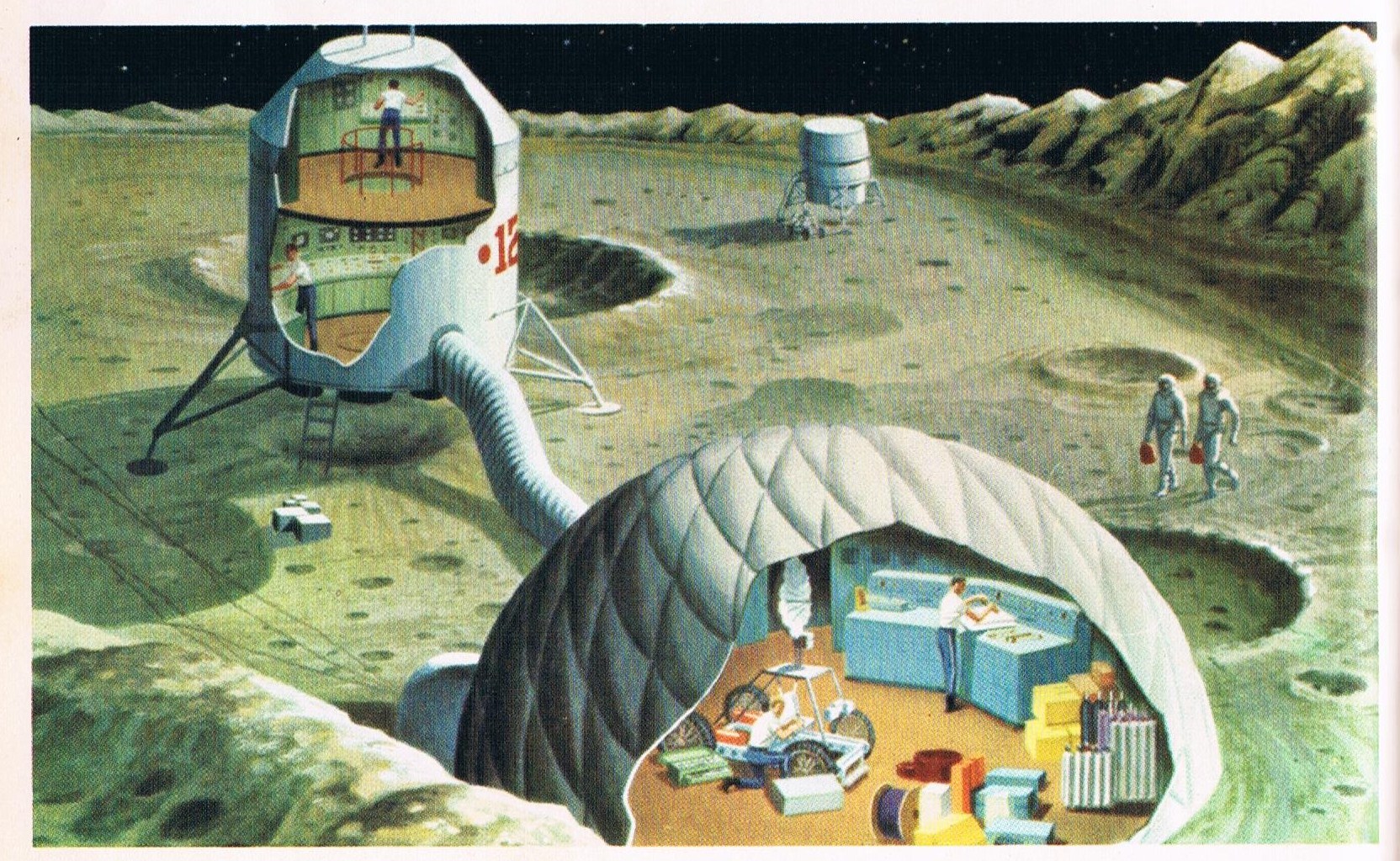 ...and this would have been for Gerald Ford's State of the Union message - Moon Base 1975
...and this would have been for Gerald Ford's State of the Union message - Moon Base 1975It might have been, it might have been! And looking at these pictures I sense the old space program time-track breathing on my neck.
But as far as our own time-line is concerned, the chance is gone, never to recur.
However, no need to despair! Since that line is gone, we have a substitute. An alternative science-fictional line has taken the opportunity to edge closer to likelihood:
Colourful WOE - that is, Weird Old Earth.
Are we headed for Zothique? Not quite. I'm making a more cheerful point.
In this line, our Jasoom, like Barsoom, is a largely self-contained planet, a giant parcel containing adventures. After all, apart from trips to Thuria and Sassoom, John Carter and his adopted people were fully occupied with the plenty of things they had to do on their own world. For a while, we must be like that. And certainly Jasoom is a colourful enough place.
Besides, the delay in space colonies is only temporary. When the fiftieth anniversary of Apollo 11 comes in two years' time, I expect some heart-searching - some public awakening on the lines of, hey, we were stupid to give up the keys to the Solar System; we've fallen sadly behind what the books used to say; let's do something about it.
The Old Space Program has lost fifty years - but what are fifty years?
2017 June 2nd:
WHO KNOWS WHAT WE'RE MISSING?
The end-of-May statistics for the site - see Page View Winners (the reason there was no Diary yesterday, as I expect you've guessed) - made me think once again of what we might be missing through ignorance of work in other languages than English. For during May the second most interested country, after the US whose people made 52% of visits to this site, was France, with 9% - three times that of my own country. Well, I hope that the successors of Verne will some day enlighten me as to what has been going on amongst themselves, and perhaps send in some examples of OSS treasures for us all to share. Nous attendons avec impatience...
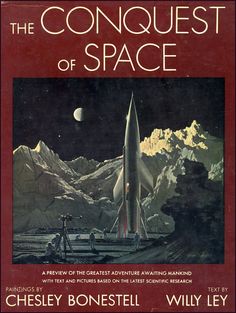
THE NON-FICTIONAL OLD SOLAR SYSTEM
Another direction I'd like to give to the site is to provide more coverage of the non-fictional OSS - the guesses which scientists, artists and commentators used to make of our neighbouring worlds. I shall be returning to this topic soon. Of course the boundary between fictional and non-fictional imaginings is never strict; no matter how distant the opposite ends of the spectrum may be from each other, the two modes are seamlessly adjacent where they join.
LOOKING AHEAD
Currently dissatisfied with the recent dearth of new pages, I want to find time to tackle the backlog of them who are clamorously waiting to be born. What seems best to me at the moment, is the idea of taking a few months off doing the Diary after the end of this month of June. The Diary will have been going on for a year by then. It has been the means by which I have plonked a huge amount of material onto the site. A lot of it hasn't been properly cross-linked, and that'll be one job I'll have more time to get on with, as well as devoting attention to new pages.
When other matters have been attended to, I will resume the Diary, health and vigor permitting - maybe as intensively as before, maybe not.









